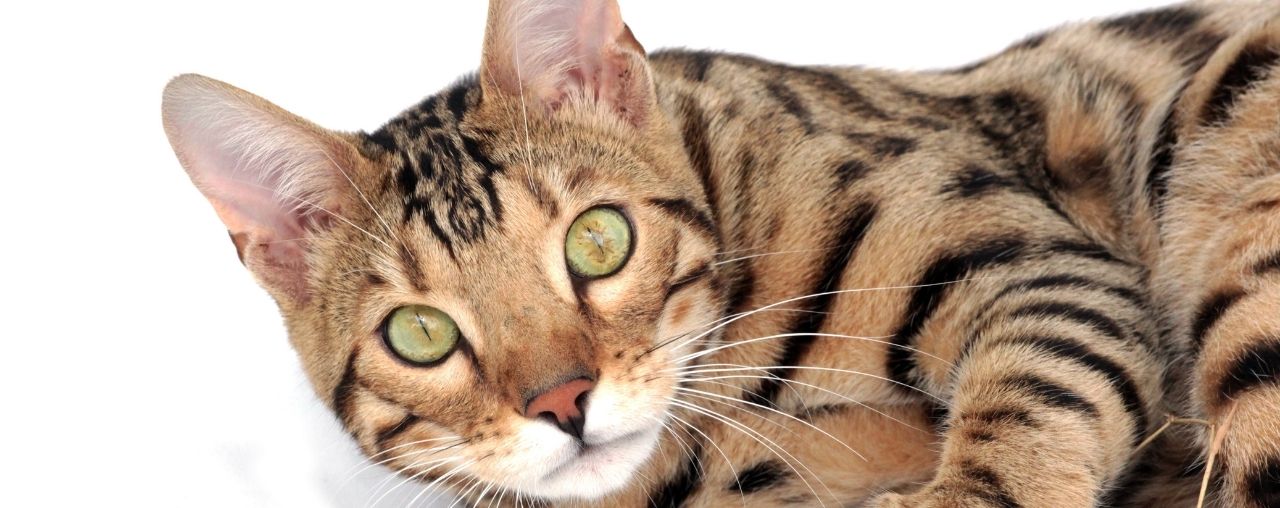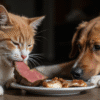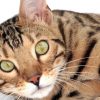-
 play_arrow
play_arrow“Human” Foods For Pets Val Cairney
- Home
- keyboard_arrow_right Cat & Kitten
- keyboard_arrow_rightPodcasts
- keyboard_arrow_rightSpotlight
- keyboard_arrow_right Spotlighting The Bengal Cat

-
 play_arrow
play_arrowSpotlighting The Bengal Cat Val Cairney
Hi everyone, and welcome to the first of a new spotlight on different breeds of cats and dogs. This episode will be spotlighting the Bengal Cat.
Every few episodes I’m going to spotlight a type of cat or dog and explore some of their history and traits and maybe answer some questions you may have about these furry, or in some cases not, so furry companions. And I would love if any listeners could visit the website for suggestions for cat breeds or with some stories to relate about owning a certain breed. So, I’m going to kick off this spotlight with a cat that I have seen in person, know a few people that have one and some that actually have more than one, and that breed is the Bengal. If you have never seen a Bengal, you are missing out. These cats have the most striking and unique markings. They look almost like little spotted leopards. And their eyes are bright and mesmerizing. The Bengal is a breed created from hybrids of domestic cats, especially the spotted Egyptian Mau, with the Asian leopard cat which is considered wild. The domestic breed stock also involves the Abyssinian cat.
According to history, a woman by the name of Jean Mill from California United States, is the person given credit for the modern Bengal.  She made the first known deliberate cross of an Asian leopard cat with a domestic cat, apparently a black Californian tomcat. In 1975 she received a group of Bengal cats which had been bred for use in genetic testing, and voila, Jean was on her way to breeding in earnest. In 1983 the breed was officially accepted by The International Cat Association and in 1997 the Governing Council of the Cat Fancy accepted Bengal cats. Now, this is really interesting. The CFA which is the Cat Fanciers Association accepted the Bengal as Miscellaneous at a board meeting in 2016. In order to register with the CFA, the cat must be at least 6 generations removed from the Asian Leopard cat or non-Bengal domestic cat ancestor.
She made the first known deliberate cross of an Asian leopard cat with a domestic cat, apparently a black Californian tomcat. In 1975 she received a group of Bengal cats which had been bred for use in genetic testing, and voila, Jean was on her way to breeding in earnest. In 1983 the breed was officially accepted by The International Cat Association and in 1997 the Governing Council of the Cat Fancy accepted Bengal cats. Now, this is really interesting. The CFA which is the Cat Fanciers Association accepted the Bengal as Miscellaneous at a board meeting in 2016. In order to register with the CFA, the cat must be at least 6 generations removed from the Asian Leopard cat or non-Bengal domestic cat ancestor.
Okay, so how big is a Bengal cat? Well they are a larger cat than our average house cats, and they are quite muscular. They are also long and lean.
In terms of the beautifully marked coats, the Bengal is said to produce lower than average levels of allergens. Now, we will have to take the word of owners on this because there hasn’t been any scientifically proven data on this, so what say you Bengal cat owners? We can’t say that they are hypoallergenic, because we know that no cat can be that, but reactions to a Bengal can be much lower, so that is helpful to people who have moderate cat allergies. And with all our animals, they require regular brushing so a good slicker brush on hand is a good idea.
Bengals come in a variety of colours. The International Cat Association recognizes brown, spotted, seal lynx Point or snow, Sepia, silver and Mink Spotted or Tabby as colours. People recognize as the most popular colour the brown spotted/rosette category. These guys look like little leopards. But there are many beautiful and unique colours that these cats can be.
So, if you looking into a Bengal cat one thing to be very aware of, is their propensity to HCM which is Hypertrophic cardiomyopathy. This is a disease in which the heart muscle becomes abnormally thick. This can make it harder for the cat’s heart to pump blood. This is a common genetic disease in Bengals and as of the last data available there was no genetic testing available. So, Bengals that are to be breed, need to go to board certified veterinary cardiologist for an echocardiogram. So, that’s a really big caution and tip for anyone thinking about getting a Bengal. Make sure that the breeding pair has been tested by a veterinary cardiologist with an echocardiogram and you are given proof that HCM is not present. You can really save yourself a world of financial hurt with this simple fact check.
Another genetic disease Bengals are prone to is progressive retinal atrophy. This is when the cells in the back of the eye that register light are destroyed and usually be 2 years of age, the cat has had significant vision loss. The test for this is done by the breeder not usually a vet. Another genetic disease to look out for is, PK deficiency. This is a disease that manifests as a chronic, intermittent, hemolytic anemia. Symptoms include lethargy, diarrhea, pale mucous membranes, lack of appetite, poor coat quality, weight loss, to name a few. Again this is a test done by the breeder. The bottom line on these two diseases is that if the breeder says the cat has been “veterinarian tested”, this does not mean these two tests have been done. So, ask for the results for these two afflictions.
Okay, last but not least, what is the temperament of a Bengal? Is this the cat for you? Bengals are very smart energetic and playful. Some owners do report the opposite that their Bengals are lazy, but personally I have only heard from people who have them, how incredibly energetic they are.  They do like to be high, so a large cat tree should be in the budget. They like to climb and they love to play. There are some cat puzzles available just as there are dog puzzles, so I would think these intelligent and curious cats could really benefit from a challenging puzzle. The other thing Bengals are known for which separates them from most other cats, is their love of water. They really need a place to run and jump and investigate.
They do like to be high, so a large cat tree should be in the budget. They like to climb and they love to play. There are some cat puzzles available just as there are dog puzzles, so I would think these intelligent and curious cats could really benefit from a challenging puzzle. The other thing Bengals are known for which separates them from most other cats, is their love of water. They really need a place to run and jump and investigate.
Overall, Bengals are quite a beautiful cat. They are very smart, very active and really require stimulation, social time, and a place to run and jump and climb. They are vocal as well so if you do not want a talkative” cat, this breed is probably not for you. Bengals are not the breed for a low key family or couple or single person that just wants a quiet lap cat. These guys are fun, energetic and want to be played with and interacted with. I might hazard a piece of advice that maybe these cats are more for an experienced cat owner. But, as long as you research the breed well and know what you are getting into, than maybe you could go for it despite not having had cats before. Personally, I wouldn’t really suggest this, just because of the Bengal owners that I have had chats with. All of them, relate just how much these cats keep them on their toes. The other things to really, really keep in mind is the health risks that come with their genetic, so I would say it is absolutely necessary that you have the paperwork and certificates
make available to you to prove that the breeding pair are free of HCM, retinol atrophy and PK deficiency. Not only are you saving yourself a lot of heartache, you are also keeping breeders transparent and responsible to making sure the breed is at its best. And that’s what we want.
Well, that’s my little snapshot into the world of Bengal cats. Stay tuned for my next profile in “Let’s get familiar with felines”. Again, I’d love to hear from any Bengal owners and your stories about these amazing cats and if you are thinking about becoming a Bengal cat parent, please do you research, Because as I say, knowing is caring!
Support The Show
For the price of a coffee, or more if you are feeling generous, you can help keep this podcast going & growing. Please visit my ko-fi page to make a donation. Thanks for all your support!
Please remember to follow or subscribe to ensure that you never miss an episode.
Please don’t forget to Rate and Review each episode that you find helpful/educational. By doing so you will help others find Val Talks Pets.
Email me at: val@valtalkspets.com with topics you think would be of interest or with any questions you may have.
Also, visit and be a part of my website at valtalkspets.com and help it grow!
Thanks for listening!
Tagged as: bengal cats, cat breeds, cat types.
Author
Val Cairney
Hi everyone, and welcome to Val Talk’s Pets, the forum for pet parents and enthusiasts alike. So, I have been working in the pet industry now for almost 10 years and, on a daily basis, I handle a lot of issues and questions arising from pet parents. I am not a veterinarian but I do have certifications in Canine, Feline, Small Animal, Fish and Herptile and Avian Health and Nutrition from the University of California, Davis Extension, the Vet College.
Similar episodes
Spotlight on the Cairn Terrier
Val Cairney August 15, 2025
Help Support This Podcast
For the price of a coffee, or more if you are feeling generous, you can help keep this podcast going & growing. Please visit my ko-fi page to make a donation. Thanks!
Search Site
Episodes By Month
Most Popular Episode
Look Back Episode
all rights reserved - Val Talks Pets - 2024






